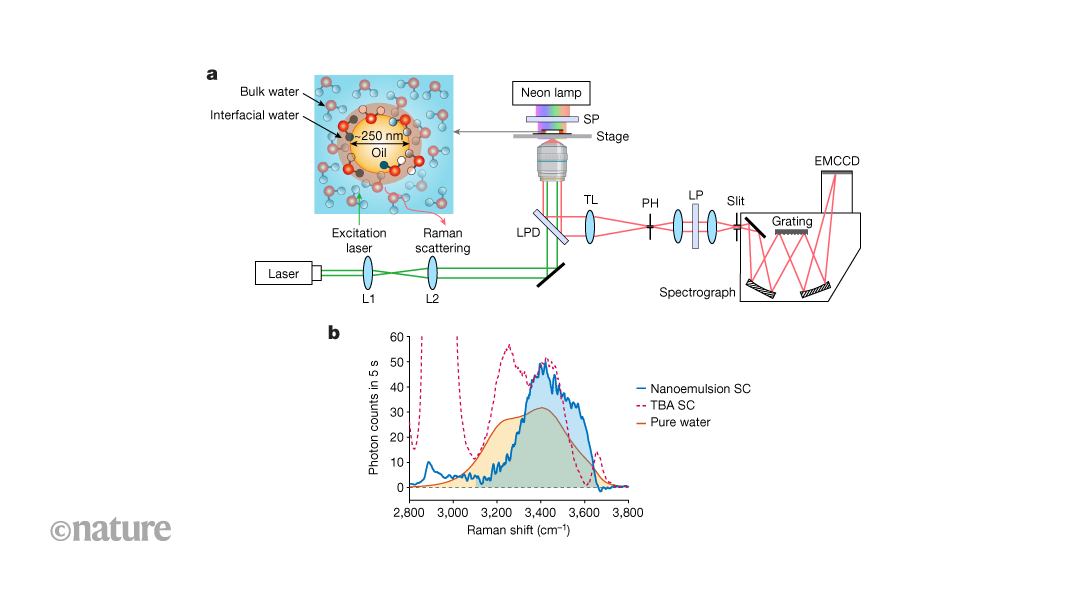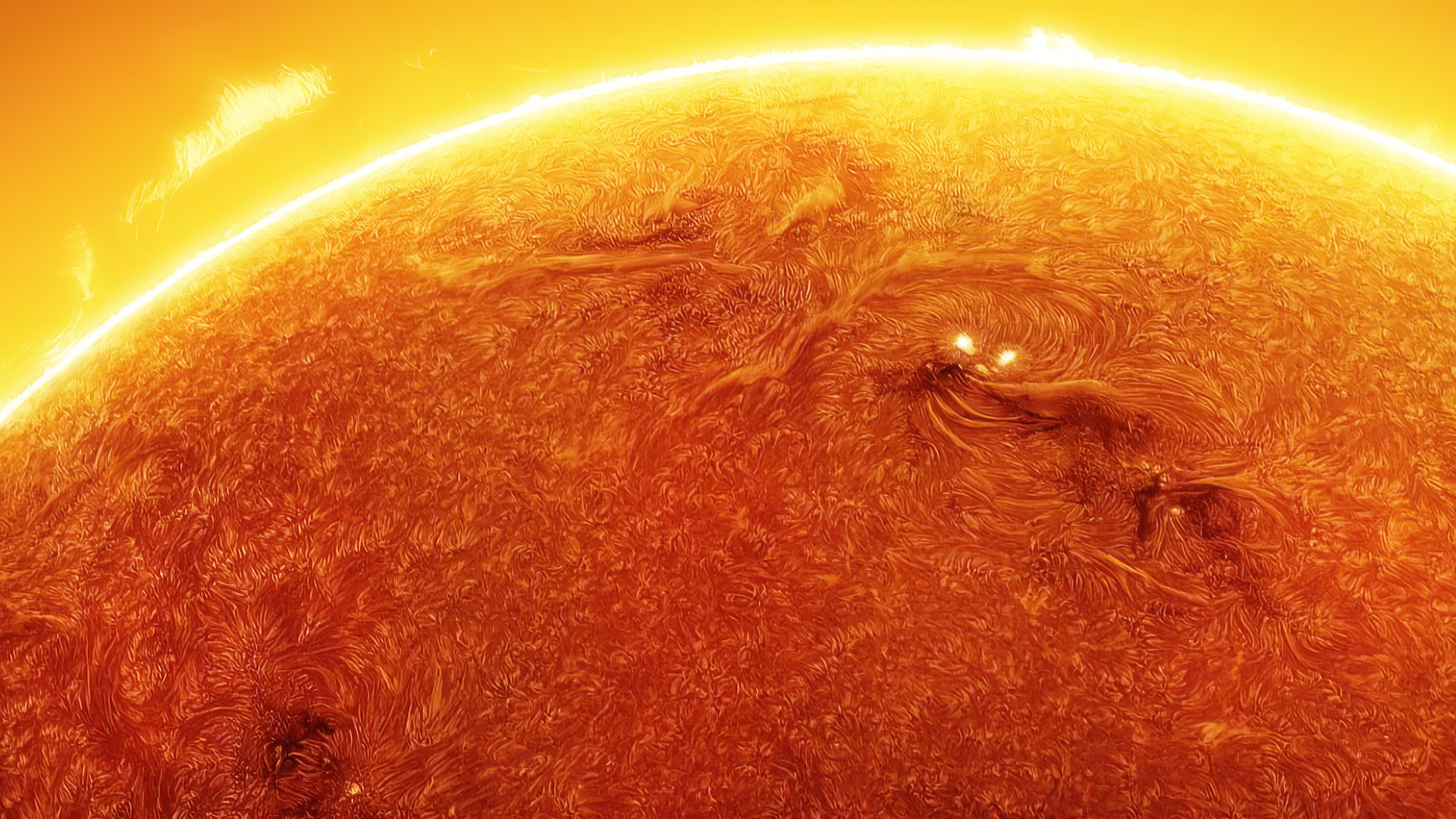0 Commentarii
0 Distribuiri
76 Views

Director
Director
-
Vă rugăm să vă autentificați pentru a vă dori, partaja și comenta!
-
 WWW.NATURE.COMExclusive: Trump White House directs NIH to study regret after transgender people transitionNature, Published online: 03 April 2025; doi:10.1038/d41586-025-01029-8After cancelling nearly all NIH projects studying transgender health, Trumps team instructs the US biomedical agency to study negative consequences of transitioning.0 Commentarii 0 Distribuiri 85 Views
WWW.NATURE.COMExclusive: Trump White House directs NIH to study regret after transgender people transitionNature, Published online: 03 April 2025; doi:10.1038/d41586-025-01029-8After cancelling nearly all NIH projects studying transgender health, Trumps team instructs the US biomedical agency to study negative consequences of transitioning.0 Commentarii 0 Distribuiri 85 Views -
 WWW.NATURE.COMIntriguing features of the interface between water and oil droplets uncoveredNature, Published online: 02 April 2025; doi:10.1038/d41586-025-00976-6Innovative experimental and computational techniques have been developed to study the interface of oil droplets suspended in water, a model system of hydrophobic interaction. These techniques reveal greater water structural disorder than in bulk water and an intense electric field at the wateroil interface.0 Commentarii 0 Distribuiri 79 Views
WWW.NATURE.COMIntriguing features of the interface between water and oil droplets uncoveredNature, Published online: 02 April 2025; doi:10.1038/d41586-025-00976-6Innovative experimental and computational techniques have been developed to study the interface of oil droplets suspended in water, a model system of hydrophobic interaction. These techniques reveal greater water structural disorder than in bulk water and an intense electric field at the wateroil interface.0 Commentarii 0 Distribuiri 79 Views -
 WWW.LIVESCIENCE.COMHas the sun already passed solar maximum?Has the sun already reached solar maximum? New data suggests Solar Cycle 25 may have peaked earlier than expected. Find out what this means.0 Commentarii 0 Distribuiri 91 Views
WWW.LIVESCIENCE.COMHas the sun already passed solar maximum?Has the sun already reached solar maximum? New data suggests Solar Cycle 25 may have peaked earlier than expected. Find out what this means.0 Commentarii 0 Distribuiri 91 Views -
 I.REDD.ITLearning blender as part of my university courses. Thoughts? (Silly answer encouraged)submitted by /u/NETSCaPE9108 [link] [comments]0 Commentarii 0 Distribuiri 78 Views
I.REDD.ITLearning blender as part of my university courses. Thoughts? (Silly answer encouraged)submitted by /u/NETSCaPE9108 [link] [comments]0 Commentarii 0 Distribuiri 78 Views -
X.COM.@sherif_a_dawoud returned to 80 Level to discuss his realistic coast material crafted in Substance 3D Designer and Marmoset Toolbag, with animation d....@sherif_a_dawoud returned to 80 Level to discuss his realistic coast material crafted in Substance 3D Designer and Marmoset Toolbag, with animation done in DaVinci Resolve.Read the interview: https://80.lv/articles/creating-realistic-animated-water-with-substance-3d-designer-marmoset-toolbag/0 Commentarii 0 Distribuiri 98 Views
-
X.COMLudivine Moro provided a detailed breakdown of the Alecia project, discussing modeling and texturing the character's head, outfit, hair, and accessori...Ludivine Moro provided a detailed breakdown of the Alecia project, discussing modeling and texturing the character's head, outfit, hair, and accessories using Blender, Maya, ZBrush, Substance 3D Painter, and Unreal Engine.Read here: https://80.lv/articles/creating-a-modern-character-with-african-vibes-with-zbrush-ue5/0 Commentarii 0 Distribuiri 92 Views
-
0 Commentarii 0 Distribuiri 64 Views
-
 WWW.GADGETS360.COMMassive X1.1-class Solar Flare Causes Radio Blackouts Across AmericaA strong solar flare of the X1.1 class caused radio outages across North and South America. GOES-16 satellite captured the incident around 11:20 a.m. EST on March 28. It is operated by National Oceanic and Atmospheric Administration (NOAA) and NASA together. The flare originated from a sunspot identified as AR4046. It is the first X-class flare detected since early February. Reports confirm that this solar event disrupted high-frequency radio communications for several hours in affected regions.Impact on Earth's radio signalsAccording to NOAA's Space Weather Prediction Center, the flare caused significant interference with high-frequency radio signals. The sudden burst of electromagnetic radiation ionised the lower ionosphere. This led to a temporary loss of contact for radio operators. The affected region included areas facing the sun at the time of the eruption. NOAA classified this as an R3-level solar event, indicating strong radio signal degradation across large portions of the sunlit hemisphere.Coronal mass ejection follows the flareNOAA confirmed that a coronal mass ejection (CME) accompanied the solar event. A CME is made up of plasma and magnetic field energy released from the sun's surface. geomagnetic disturbances are likely to occur when these ejections interact with the Earth's magnetic field. Scientists are analysing data to determine if any impact on Earth is possible. Current assessments say that this CME will most likely not be directed toward Earth.More solar activity expectedSolar physicist Ryan French stated in a post on X that sunspot AR4046 is rotating to face Earth in the coming days. Future solar flares from this region could directly impact Earth. Another sunspot, AR4048, has also been identified as a potential source of powerful solar activity. Reports indicate a 15 percent likelihood of another X-class solar flare occurring between March 31 and April 2.0 Commentarii 0 Distribuiri 117 Views
WWW.GADGETS360.COMMassive X1.1-class Solar Flare Causes Radio Blackouts Across AmericaA strong solar flare of the X1.1 class caused radio outages across North and South America. GOES-16 satellite captured the incident around 11:20 a.m. EST on March 28. It is operated by National Oceanic and Atmospheric Administration (NOAA) and NASA together. The flare originated from a sunspot identified as AR4046. It is the first X-class flare detected since early February. Reports confirm that this solar event disrupted high-frequency radio communications for several hours in affected regions.Impact on Earth's radio signalsAccording to NOAA's Space Weather Prediction Center, the flare caused significant interference with high-frequency radio signals. The sudden burst of electromagnetic radiation ionised the lower ionosphere. This led to a temporary loss of contact for radio operators. The affected region included areas facing the sun at the time of the eruption. NOAA classified this as an R3-level solar event, indicating strong radio signal degradation across large portions of the sunlit hemisphere.Coronal mass ejection follows the flareNOAA confirmed that a coronal mass ejection (CME) accompanied the solar event. A CME is made up of plasma and magnetic field energy released from the sun's surface. geomagnetic disturbances are likely to occur when these ejections interact with the Earth's magnetic field. Scientists are analysing data to determine if any impact on Earth is possible. Current assessments say that this CME will most likely not be directed toward Earth.More solar activity expectedSolar physicist Ryan French stated in a post on X that sunspot AR4046 is rotating to face Earth in the coming days. Future solar flares from this region could directly impact Earth. Another sunspot, AR4048, has also been identified as a potential source of powerful solar activity. Reports indicate a 15 percent likelihood of another X-class solar flare occurring between March 31 and April 2.0 Commentarii 0 Distribuiri 117 Views -
 MEDIUM.COMReinforcement Learning: A Guide to Building Smarter ChatbotsReinforcement Learning: A Guide to Building Smarter Chatbots4 min readJust now--Reinforcement Learning (RL) is a type of machine learning where an agent learns to make the best decisions by interacting with its environment. This article explains RL step by step, discusses its advantages and challenges, describes its system architecture and flow, and shows a practical example in chatbot development. At the end, youll also find an explanation in very simple baby language for quick understanding.1. What Is Reinforcement Learning?Reinforcement Learning is all about learning by doing. Instead of being told what the right answer is, an RL agent learns by trying different actions and receiving rewards or penalties. The goal is to maximize the total reward over time.Key Idea:The agent explores the environment.It receives feedback (reward or punishment).It updates its strategy (policy) to perform better in the future.2. Pros and Cons of Reinforcement LearningProsAdaptive Learning: The agent learns and adjusts based on experiences.Autonomy: Once trained, the system can work on its own.Innovative Solutions: RL can sometimes find new strategies that are not obvious to human designers.Scalable: Suitable for both small tasks and complex problems like robotics or finance.ConsData Intensive: Requires many trials and interactions to learn effectively.Stability Issues: Learning can be unstable, needing careful tuning.Generalization Limits: An agent might perform well in one setting but struggle in new or varied environments.Exploration vs. Exploitation: Finding the right balance between trying new actions and using known successful ones is challenging.3. Architecture of a Reinforcement Learning SystemAn RL system usually consists of the following components:Agent: The decision-maker that interacts with the environment.Environment: The world or system the agent interacts with (e.g., a chatbot service).State: The current situation or context the agent is in.Action: The decisions or moves the agent can take.Reward Signal: Feedback provided by the environment after an action.Policy: A strategy that maps states to actions.Value Function: A measure of how good a particular state or action is over time.4. The Flow of Reinforcement LearningThe process typically follows these steps:Initialization: The agent starts with an initial, often random, strategy.Observation: It observes the current state of the environment.Action Selection: It picks an action based on its current policy.Feedback: The environment responds with a new state and a reward.Learning: The agent adjusts its policy based on the reward.Iteration: This cycle repeats until the agents strategy becomes optimal.5. Real-World Example: Building a ChatbotImagine you are building a chatbot to provide academic information at a university. Heres how RL can be applied:Step-by-Step Chatbot ExampleDefine the Environment:The chatbot interacts with students who ask questions.The environment consists of the database of academic procedures (e.g., how to apply for a scholarship or register for classes).Set Up the Agent:The agent (chatbot) starts with a basic set of responses.It uses an RL algorithm (e.g., Q-learning or a Deep Q-Network) to improve over time.2. Initial Interaction:When a student asks a question, the chatbot selects an answer based on its current policy.For example, if a student asks, How do I apply for a scholarship? the chatbot gives its best guess3. Receive Feedback:If the student finds the answer helpful, the chatbot receives a positive reward.If the answer is not helpful, a negative reward is given.4. Policy Update:The chatbot uses this reward information to adjust its strategy.Over time, it learns to provide more accurate and helpful responses.5. Continuous Improvement:With each interaction, the chatbot refines its responses, leading to a better user experience and more effective academic information delivery.6. Explanation in Baby LanguageImagine you have a little robot friend who learns by playing a game.Robot Friend: This is like our RL agent.Playground: The playground is the environment where the robot plays.Try and Learn: Every time the robot tries a new move (action), someone claps (reward) if its good, or shakes their head (punishment) if its not.Getting Better: The robot listens to the claps and head shakes. Soon, it learns which moves make people clap a lot!Chatbot Example: Now, imagine the robot is a talking friend who helps answer questions. At first, it might say funny things, but as it hears more claps (good responses) and head shakes (bad responses), it learns to give better answers.7. ConclusionReinforcement Learning is a dynamic and powerful method that enables systems such as chatbots to learn from their interactions and improve over time. While it has challenges like requiring many interactions and careful tuning, its ability to adapt and find innovative solutions makes it a promising approach for a wide range of applications. In the context of chatbot development, RL helps create systems that not only respond to queries but also continuously learn to provide more accurate and helpful information.By understanding the architecture and flow of RL, and seeing a real-life application in building an academic chatbot, you can appreciate both the complexity and the potential of this technology. And if you ever need a really simple explanation, just remember: its like a little robot friend learning from claps and head shakes to become super smart!BonusRelateable Meme Right Now . Source : https://medium.com/nybles/understanding-machine-learning-through-memes-4580b67527bf0 Commentarii 0 Distribuiri 82 Views
MEDIUM.COMReinforcement Learning: A Guide to Building Smarter ChatbotsReinforcement Learning: A Guide to Building Smarter Chatbots4 min readJust now--Reinforcement Learning (RL) is a type of machine learning where an agent learns to make the best decisions by interacting with its environment. This article explains RL step by step, discusses its advantages and challenges, describes its system architecture and flow, and shows a practical example in chatbot development. At the end, youll also find an explanation in very simple baby language for quick understanding.1. What Is Reinforcement Learning?Reinforcement Learning is all about learning by doing. Instead of being told what the right answer is, an RL agent learns by trying different actions and receiving rewards or penalties. The goal is to maximize the total reward over time.Key Idea:The agent explores the environment.It receives feedback (reward or punishment).It updates its strategy (policy) to perform better in the future.2. Pros and Cons of Reinforcement LearningProsAdaptive Learning: The agent learns and adjusts based on experiences.Autonomy: Once trained, the system can work on its own.Innovative Solutions: RL can sometimes find new strategies that are not obvious to human designers.Scalable: Suitable for both small tasks and complex problems like robotics or finance.ConsData Intensive: Requires many trials and interactions to learn effectively.Stability Issues: Learning can be unstable, needing careful tuning.Generalization Limits: An agent might perform well in one setting but struggle in new or varied environments.Exploration vs. Exploitation: Finding the right balance between trying new actions and using known successful ones is challenging.3. Architecture of a Reinforcement Learning SystemAn RL system usually consists of the following components:Agent: The decision-maker that interacts with the environment.Environment: The world or system the agent interacts with (e.g., a chatbot service).State: The current situation or context the agent is in.Action: The decisions or moves the agent can take.Reward Signal: Feedback provided by the environment after an action.Policy: A strategy that maps states to actions.Value Function: A measure of how good a particular state or action is over time.4. The Flow of Reinforcement LearningThe process typically follows these steps:Initialization: The agent starts with an initial, often random, strategy.Observation: It observes the current state of the environment.Action Selection: It picks an action based on its current policy.Feedback: The environment responds with a new state and a reward.Learning: The agent adjusts its policy based on the reward.Iteration: This cycle repeats until the agents strategy becomes optimal.5. Real-World Example: Building a ChatbotImagine you are building a chatbot to provide academic information at a university. Heres how RL can be applied:Step-by-Step Chatbot ExampleDefine the Environment:The chatbot interacts with students who ask questions.The environment consists of the database of academic procedures (e.g., how to apply for a scholarship or register for classes).Set Up the Agent:The agent (chatbot) starts with a basic set of responses.It uses an RL algorithm (e.g., Q-learning or a Deep Q-Network) to improve over time.2. Initial Interaction:When a student asks a question, the chatbot selects an answer based on its current policy.For example, if a student asks, How do I apply for a scholarship? the chatbot gives its best guess3. Receive Feedback:If the student finds the answer helpful, the chatbot receives a positive reward.If the answer is not helpful, a negative reward is given.4. Policy Update:The chatbot uses this reward information to adjust its strategy.Over time, it learns to provide more accurate and helpful responses.5. Continuous Improvement:With each interaction, the chatbot refines its responses, leading to a better user experience and more effective academic information delivery.6. Explanation in Baby LanguageImagine you have a little robot friend who learns by playing a game.Robot Friend: This is like our RL agent.Playground: The playground is the environment where the robot plays.Try and Learn: Every time the robot tries a new move (action), someone claps (reward) if its good, or shakes their head (punishment) if its not.Getting Better: The robot listens to the claps and head shakes. Soon, it learns which moves make people clap a lot!Chatbot Example: Now, imagine the robot is a talking friend who helps answer questions. At first, it might say funny things, but as it hears more claps (good responses) and head shakes (bad responses), it learns to give better answers.7. ConclusionReinforcement Learning is a dynamic and powerful method that enables systems such as chatbots to learn from their interactions and improve over time. While it has challenges like requiring many interactions and careful tuning, its ability to adapt and find innovative solutions makes it a promising approach for a wide range of applications. In the context of chatbot development, RL helps create systems that not only respond to queries but also continuously learn to provide more accurate and helpful information.By understanding the architecture and flow of RL, and seeing a real-life application in building an academic chatbot, you can appreciate both the complexity and the potential of this technology. And if you ever need a really simple explanation, just remember: its like a little robot friend learning from claps and head shakes to become super smart!BonusRelateable Meme Right Now . Source : https://medium.com/nybles/understanding-machine-learning-through-memes-4580b67527bf0 Commentarii 0 Distribuiri 82 Views






